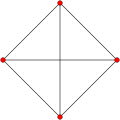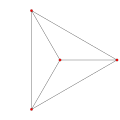Top Qs
Timeline
Chat
Perspective
Tetrahedral cupola
From Wikipedia, the free encyclopedia
Remove ads
In 4-dimensional geometry, the tetrahedral cupola is a polychoron bounded by one tetrahedron, a parallel cuboctahedron, connected by 10 triangular prisms, and 4 triangular pyramids.[1]
This article relies largely or entirely on a single source. (April 2024) |
| Tetrahedral cupola | ||
|---|---|---|
 Schlegel diagram | ||
| Type | Polyhedral cupola | |
| Schläfli symbol | {3,3} v rr{3,3} | |
| Cells | 16 | 1 rr{3,3} 1+4 {3,3} 4+6 {}×{3} |
| Faces | 42 | 24 triangles 18 squares |
| Edges | 42 | |
| Vertices | 16 | |
| Dual | ||
| Symmetry group | [3,3,1], order 24 | |
| Properties | convex, regular-faced | |
Remove ads
Related polytopes
The tetrahedral cupola can be sliced off from a runcinated 5-cell, on a hyperplane parallel to a tetrahedral cell. The cuboctahedron base passes through the center of the runcinated 5-cell, so the Tetrahedral cupola contains half of the tetrahedron and triangular prism cells of the runcinated 5-cell. The cupola can be seen in A2 and A3 Coxeter plane orthogonal projection of the runcinated 5-cell:
Remove ads
See also
- Tetrahedral pyramid (5-cell)
References
External links
Wikiwand - on
Seamless Wikipedia browsing. On steroids.
Remove ads






